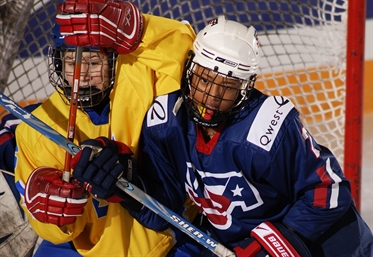WW Top 25 Stories: #14
WW Top 25 Stories: #14
IIHF removes body-checking from women’s hockey

 Sweden and the U.S. battle for the better position in front of the net. With body-checking being taken out of the game, women’s hockey differs from the men’s game in the physical component. Photo: Matthew Manor / HHOF-IIHF Images
Sweden and the U.S. battle for the better position in front of the net. With body-checking being taken out of the game, women’s hockey differs from the men’s game in the physical component. Photo: Matthew Manor / HHOF-IIHF Images
The 1987 unofficial tournament had it, and all nations seemed to like it, but after 1990 it became clear that the bigger, faster, and stronger North American teams had a size advantage that was so intimidating that it likely would harm rather than encourage the development of the women’s game worldwide.
Since then, the focus has been entirely predicated on developing skills – skating, shooting, passing, and training. By so doing, the women’s game has distanced itself from the men’s version, which is reliant on physical play both for gaining possession of the puck and attracting fans to the arenas and television sets.
By creating this distance, the woman’s game is also reaching out to fans who aren’t fond of the physical play, which so often leads to rougher play and fisticuffs, trying to attract a new kind of hockey fan, a fan who admires the skill and speed of the game but has no interest in the physical component taking away from those aspects of the game.
In truth, it is the biggest difference in style of play between men’s and women’s hockey, and it is also the most significant rule difference as well (along with the fact that all women must wear helmets with full face protection).
Indeed, the banning of body-checking has forced players to strip an opponent of the puck in more skillful ways while avoiding injury to both the puck carrier and opponent. Hitting from behind is a rare penalty call in the women’s game, as are penalties for checking to the head or neck. Players must use positioning and speed to gain puck possession. The use of the boards for body-checking is almost non-existent.
Continue readingCritics of the women’s game argue that hitting is an inherent part of the game, and recent studies which show that women are more prone to concussions in sports also perhaps suggest that a cause for this is the lack of practice with physical contact (if one expects a hit, one is prepared for it; if one isn’t expecting a hit, the results can be more damaging). However, in ice hockey the injury rate is lower for women than for men also due to the no-hitting rule.
Either way, the no-hitting rule is certainly an inherent part of the women’s game and isn’t likely to be changed in the near future. The rule allows for greater flow and for speed to trump all on-ice skills, and if it distances the women’s game from the men’s, well, women are all for that, too.
In celebration of the 25th anniversary of women's hockey in the IIHF, writer Andrew Podnieks is counting down the top 25 stories in women's international hockey history. One story each day will appear until the Number 1 story is unveiled the morning of the gold-medal game of the 2015 Women's Worlds in Malmo, Sweden, on April 4.
Earlier Top 25 Stories:
#15: Jenni Hiirikoski becomes first Euro two-timer
#16: Former NHLer Yashin leads Russian women to bronze
#17: Cammi Granato cut before Turin
#18: Visitors win twice in North American finals
#19: IIHF makes Women’s Worlds official for 1990
#20: Rogge issues challenge to women’s hockey
#21: IIHF goes to all-women officials
#22: Shannon Miller recruits Euros for NCAA
#23: IIHF introduces junior event for women
#24: Zorn a goalie and skater both
#25: Russia-Switzerland a dandy display in 2011
Back to Overview























































